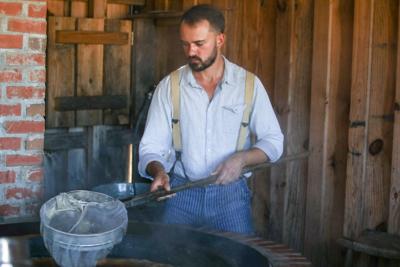When the cash crops were in, and the vegetables were harvested, the last thing standing on an Horry County farm in the first half of the 20th century was usually sugar cane.
That was the case at the L.W. Paul Living History Farm near Conway on Saturday, Nov. 18, where they still make sweetener, and farm the land, the old-fashioned way.
Hundreds of visitors came out for what’s become known as "Syrup Day."
Volunteer Jim King handled the harvest, using the backside of a machete to bare the stalk on sugar cane plants, and the sharp side to whack them down just above the ground.

He tosses the trimmings onto the adjacent row of stubble, explaining that he's insulating the stalks to avoid freezing, so they’ll grow back next year.
“Is it bamboo,” asked visitors Ethan Barnes, 9, and Gabriel Barnes, 7, of Conway. Their mother, Tiffany Barnes, said the children were excited to visit because they like everything to do with sugar.
Pat Artman, a retiree visiting with a history club from Bolivia, North Carolina, made the same misidentification. “Never too old to learn …,” she laughed about mistaking cane for bamboo.
It’s a common error, said King, who hands visitors the heavy sugar cane stalks swollen with juices, to help illustrate how the cane differs from the bamboo the Barnes brothers and Artman were familiar with.
King directs the guests to the tobacco barn, where volunteers Larry Woodle and King’s wife Linda are handing out bite-size chunks of sugar cane. Guests suck the juice from the fiber, which is sweet, about 10% sugar.
The stalks that Jim King cut are loaded into a sled and dragged by mule to the mill, operated by Living History Farm Director Walter Hill on the other side of the 17-acre farm at 2279 Harris Shortcut Road. It was constructed in 2006 by Horry County native and philanthropist Larry Paul, who had ties to local agriculture.
The farm is operated by the Horry County Museum, and features seasonal ag activities that illustrate life in Horry County from 1900 to 1955. Admission is free, and the farm is open from 9 a.m. to 4 p.m. Tuesdays through Saturdays.
Hill ran the mill and kept up a running dialogue with inquisitive guests, while a mule pulled the sweep to crush the cane and extract the juice. It was then boiled down and skimmed in a massive cast-iron kettle, yielding syrup by the end of the day. The farm raises a half-acre of sugar cane, and makes about 25-30 gallons of syrup per year.
November was syrup season back in the day, after all other heavy harvesting had been completed. You just had to be sure to cut the cane before a frost, which turns the cane dormant and sends the sugar back to the roots, Hill said.
Unlike white sugar and maple syrup, Hill said the cane syrup “was easily available, and very cheap; neither labor-intensive nor costly.” Thus, it was the sweetener of choice for farm families.
Visitor Gary Quilliam, the leader of the history club from North Carolina, said he was impressed with the docents and the insights provided.
“They’re very knowledgeable,” he said.
And Woodle, who grew up on an Horry County farm, said he likewise was impressed with the visitors.
“They really get interested; they have lots of good questions,” Woodle said. “We’re letting them know how their grandparents lived.”
“People have lost touch” with their roots, Linda King said, noting that the past is preserved here. “That’s what the farm is for."









(0) comments
Welcome to the discussion.
Log In
Keep it Clean. Please avoid obscene, vulgar, lewd, racist or sexually-oriented language.
PLEASE TURN OFF YOUR CAPS LOCK.
Don't Threaten. Threats of harming another person will not be tolerated.
Be Truthful. Don't knowingly lie about anyone or anything.
Be Nice. No racism, sexism or any sort of -ism that is degrading to another person.
Be Proactive. Use the 'Report' link on each comment to let us know of abusive posts.
Share with Us. We'd love to hear eyewitness accounts, the history behind an article.